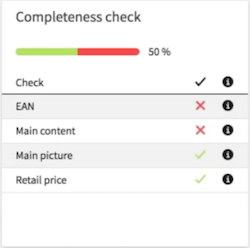A completeness check shows if an asset meets a defined data quality. Completeness checks can be defined for any asset property or asset relation. Completeness checks have no defined order and are not associated to a certain quality level.
Prerequisites
Completeness checks have been configured for you by a solution developer.
Introduction
To make sure that an asset contains a defined set of data, for example, a product has an EAN number, you can define a completeness check. The completeness check tests if this information exists in the respective asset. For example, the completeness check tests if a value is stored in the "EAN" property of a product.

Here are examples of completeness checks:
Order number
Category assigned
GTIN code (Global Trade Item Number)
EAN code (International Article Number)
Mandatory properties of assigned categories
Image assigned
Description
The status of a single completeness check is either true or false.
The overall state of multiple completeness checks is shown in a progress bar (in percent). Only required completeness checks are taken into account. Optional completeness checks are displayed in a separate section.
Working with completeness checks
The Quality check widget and Asset status widget show a list of completeness checks. There are two sections: one for the required and one for the optional completeness checks. The progress bar shows how many completeness checks of the current asset are passed (in percent).
Icon | Meaning |
| Task is in progress. Hover over the icon to see a tooltip with a short task description. |
| Completeness check is done. |
You cannot change the status of a completeness check. This is done automatically if the asset meets the condition that is defined in the completeness check.
Completeness checks can be used to build quality gates and quality gate sequences.